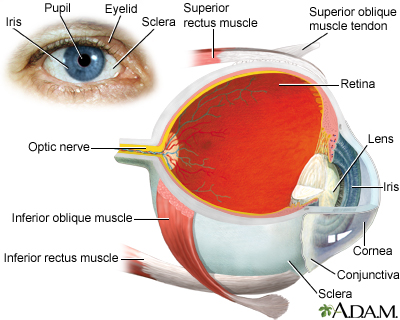Long term complications of diabetes
Diabetic complications - long term

The eye is the organ of sight, a nearly spherical hollow globe filled with fluids (humors). The outer layer or tunic (sclera, or white, and cornea) is fibrous and protective. The middle layer (choroid, ciliary body and the iris) is vascular. The innermost layer (the retina) is nervous or sensory. The fluids in the eye are divided by the lens into the vitreous humor (behind the lens) and the aqueous humor (in front of the lens). The lens itself is flexible and suspended by ligaments which allow it to change shape to focus light on the retina, which is composed of sensory neurons.

People with diabetes are prone to foot problems because the disease can cause damage to the blood vessels and nerves, which may result in decreased ability to sense a trauma to the foot. The immune system is also altered, so that the person with diabetes cannot efficiently fight infection.

Diabetes causes an excessive amount of glucose to remain in the blood stream which may cause damage to the blood vessels. Within the eye the damaged vessels may leak blood and fluid into the surrounding tissues and cause vision problems.

During diabetic nephropathy the kidney becomes damaged and more protein than normal collects in the urine. As the disease progresses, more of the kidney is destroyed. Over time, the kidneys ability to function starts to decline, which may eventually lead to chronic kidney failure.
Take Control of Your Diabetes
Keeping your blood sugar in a healthy range reduces the chance of all of the complications from diabetes.
It is important to keep your blood pressure and cholesterol in a healthy range as well.
You should learn these basic steps for managing diabetes and staying as healthy as possible. Steps may include:
- A healthy diet
- Physical activity
- Medicines
You may need to check your blood sugar daily or more often. Your health care provider will also help you by ordering blood tests and other tests. All these may help you keep complications of diabetes away.
If you need to check your blood sugar level at home.
- You may use a device called a glucose meter to test your blood sugar. Your provider will let you know if you need to check it every day and how many times each day.
- You may use a device called a glucose sensor (also called a continuous glucose monitor) that attaches to your body. Your provider will tell you if this is a better choice for you.
- Your provider will also tell you what blood sugar numbers you are trying to achieve. This is called managing your blood sugar. These goals will be set for different times during the day.
To prevent heart disease and stroke, you may be asked to take medicine and change your diet and activity:
- Your provider may ask you to take a medicine called an ACE inhibitor or a different medicine called an ARB, for high blood pressure or kidney problems.
- Your provider may ask you to take a medicine called a statin or other medicines to keep your cholesterol down.
- Your provider may ask you to take aspirin to prevent heart attacks. Ask your provider if aspirin is right for you.
- Regular exercise is good for people with diabetes. Talk to your provider first about what exercises are best for you and how much exercise you should do every day.
- Do not smoke. Smoking makes diabetes complications worse. If you do smoke, work with your provider to find a way to quit.
To keep your feet healthy, you should:
- Check and care for your feet every day. Keep your skin well moisturized.
- Get a foot exam by your provider at least every 6 to 12 months and learn whether you have nerve damage.
- Make sure you are wearing the right kinds of socks and shoes.
A nurse or dietitian will teach you about good food choices to lower your blood sugar and stay healthy. Make sure you know how to put together a balanced meal with protein and fiber.
See Your Doctor Often
If you have diabetes, you should see your provider every 3 months. At these visits your provider may:
- Ask about your blood sugar level (always bring your blood glucose meter to every visit if you are checking your blood sugar at home)
- Check your blood pressure
- Check the feeling in your feet
- Check the skin and bones of your feet and legs
- Examine the back part of your eyes
The provider may also send you to the lab for blood and urine tests to:
- Make sure your kidneys are working well (every year)
- Make sure your cholesterol and triglyceride levels are healthy (every year)
- Check your HbA1C level to see how well your blood sugar is controlled (every 3 to 6 months)
Visit your dentist every 6 months. You should see your eye doctor once a year. Your provider may ask you to see your eye doctor more often.
References
American Diabetes Association Professional Practice Committee website. 5. Facilitating positive health behaviors and well-being to improve health outcomes: standards of medical care in diabetes-2024. Diabetes Care. 2024;47(Suppl 1):S77-S110. PMID: 38078584
Brownlee M, Aiello LP, Sun JK, et al. Complications of diabetes mellitus. In: Melmed S, Auchus, RJ, Goldfine AB, Koenig RJ, Kopp PA, eds. Williams Textbook of Endocrinology. 15th ed. Philadelphia, PA: Elsevier; 2025:chap 38.
Version Info
Last reviewed on: 7/21/2024
Reviewed by: Sandeep K. Dhaliwal, MD, board-certified in Diabetes, Endocrinology, and Metabolism, Springfield, VA. Also reviewed by David C. Dugdale, MD, Medical Director, Brenda Conaway, Editorial Director, and the A.D.A.M. Editorial team.
